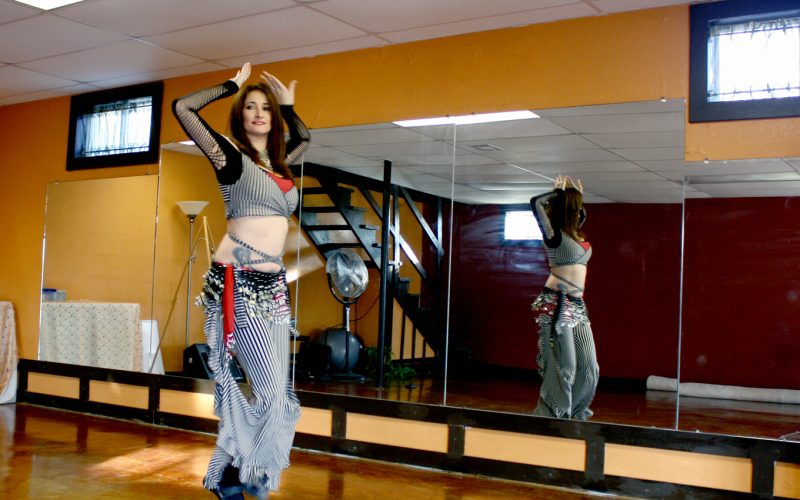
Staff Photo Nick Brothers
Sahlah Tepes demonstrates the intricacies of isolating stomach muscles to sync up with the rhythm of music at Amani Dance Studio in Fayetteville.
Moving like a serpent to the rhythm of Spanish guitars and Arabic words, Sahlah Tepes performs the intricacies of belly dancing. Each move requires a focus on a different muscle in the body while moving across the floor, and the dance requires each muscle to mimic the beats of the drums.
The style of belly dancing is called fusion, and Tepes has been an instructor of it since 2003. She will be starting a course in belly dancing at Amani Dance Studio at 4627 E. Mission Blvd. in Fayetteville this January.
Belly dancing is more than a life passion for Tepes, it’s also responsible for helping her find healing from a spine injury in 2004.
The car accident involved a drunk driver. The impact shot out the disc that sat between her spine’s vertebrae, and she had to undergo surgery to have it removed. To this day, she is still bone on bone at that spot. She had to walk with a hunch to deal with the pain in her back. Her doctor told her that there was a high possibility that she would never be able to dance or walk normal again.
“I looked at him and told him, ‘Watch me.’” Tepes recalled.
Five days later, Tepes returned to teaching with a back brace and verbally coached her students for a year. While difficult at times, she was still able to demonstrate a few dance moves to the class with limited movements. After getting her flexibility back up, she got back into belly dancing. Toning her back muscles helped alleviate the pain from moving around, she said.
“It was a life changer for me,” Tepes said about getting “lost” in belly dancing. “It’s definitely a place where you feel no pain. That is one of the reasons I was able to heal my spine. No drugs, just using yoga techniques and conditioning the muscles we use in belly dancing.”
While difficult at first to pick up on isolating the muscle movements, belly dancing can be picked up by anyone, Tepes said.
“My nickname is Spock, and I love anything that is technically difficult,” she said. “Belly dancing is an extremely technical dance that requires a lot of muscle control and it takes a lot of time and serious effort to really master the movement of muscles independent from one another.”
Despite the popularity of the dance with women, even men can be taught belly dancing. Body type doesn’t matter, either. Some of Tepes’ best students have been men, she said — although they prefer to think of it as tribal dancing, and often accompany the dance with martial arts training.
Classes will commence on Wednesday Jan. 7 at Amani Dance Studio at 4627 E. Mission Blvd. Class times will be from 6 to 7 p.m. and from 7 to 8 p.m. More classes may be added if the class grows.
To enroll in the class, there is a fee of $35 per month for one day a week per month, and two days per week for a month is $50.00. Drop-in or paying by the day is $10.00.
For that first night, anyone who brings in this article can take the first class for free, but only for Jan. 7. Additionally, private lessons are available at $20.00 per hour and by appointment only because of studio availability. The only required things for the class are yoga-like work out attire and a yoga mat. Tepes said she plans on making the class very welcoming and inclusive, a place where students can relax.
“It’s a self-confidence booster,” Tepes said. “I’ve had girls walk through my door, just in the worst mood. By the time they leave class they’re happy and feeling good and thanking me for pulling them out of their depression. So I think there’s benefits there, too.”
Often referred to as the world’s oldest dance, belly dancing is believed to have had a long history in the harems of the Middle East as a way for the women of the harem to entertain themselves and prepare for child birth.
The origin of the name “Belly Dance” comes from the French “Danse du Ventre,” which translates as “dance of the stomach.”



